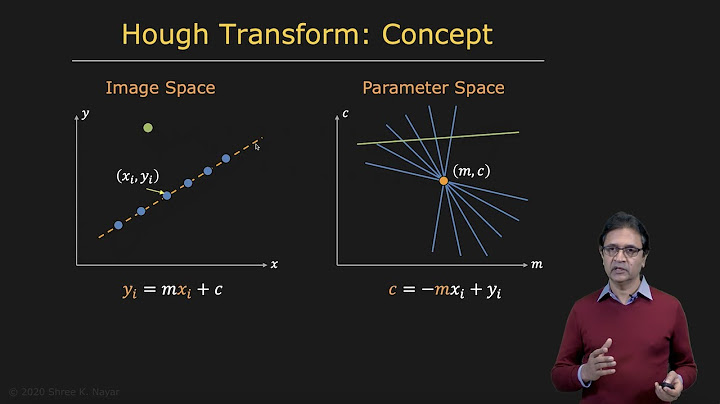Ellipse Detection using Hough Transform
Solution 1
Although this is an old question, perhaps what I found can help someone.
The main problem of using the normal Hough Transform to detect ellipses is the dimension of the accumulator, since we would need to vote for 5 variables (the equation is explained here):
There is a very nice algorithm where the accumulator can be a simple 1D array, for example, and that runs in . If you wanna see code, you can look at here (the image used to test was that posted above).
Solution 2
If you use circle for rough transform is given as rho = xcos(theta) + ysin(theta)
For ellipse since it is 
You could transform the equation as rho = axcos(theta) + bysin(theta) Although I am not sure if you use standard Hough Transform, for ellipse-like transforms, you could manipulate the first given function.
Solution 3
If your ellipse is as provided, being a true ellipse and not a noisy sample of points; the search for the two furthest points gives the ends of the major axis, the search for the two nearest points gives the ends of the minor axis, the intersection of these lines (you can check it's a right angle) occurs at the centre.
Related videos on Youtube
Ata
Updated on January 29, 2020Comments
-
Ata over 4 years
using Hough Transform, how can I detect and get coordinates of (x0,y0) and "a" and "b" of an ellipse in 2D space?
This is ellipse01.bmp:

I = imread('ellipse01.bmp'); [m n] = size(I); c=0; for i=1:m for j=1:n if I(i,j)==1 c=c+1; p(c,1)=i; p(c,2)=j; end end end Edges=transpose(p); Size_Ellipse = size(Edges); B = 1:ceil(Size_Ellipse(1)/2); Acc = zeros(length(B),1); a1=0;a2=0;b1=0;b2=0; Ellipse_Minor=[];Ellipse_Major=[];Ellipse_X0 = [];Ellipse_Y0 = []; Global_Threshold = ceil(Size_Ellipse(2)/6);%Used for Major Axis Comparison Local_Threshold = ceil(Size_Ellipse(1)/25);%Used for Minor Axis Comparison [Y,X]=find(Edges); Limit=numel(Y); Thresh = 150; Para=[]; for Count_01 =1:(Limit-1) for Count_02 =(Count_01+1):Limit if ((Count_02>Limit) || (Count_01>Limit)) continue end a1=Y(Count_01);b1=X(Count_01); a2=Y(Count_02);b2=X(Count_02); Dist_01 = (sqrt((a1-a2)^2+(b1-b2)^2)); if (Dist_01 >Global_Threshold) Center_X0 = (b1+b2)/2;Center_Y0 = (a1+a2)/2; Major = Dist_01/2.0;Alpha = atan((a2-a1)/(b2-b1)); if(Alpha == 0) for Count_03 = 1:Limit if( (Count_03 ~= Count_01) || (Count_03 ~= Count_02)) a3=Y(Count_03);b3=X(Count_03); Dist_02 = (sqrt((a3 - Center_Y0)^2+(b3 - Center_X0)^2)); if(Dist_02 > Local_Threshold) Cos_Tau = ((Major)^2 + (Dist_02)^2 - (a3-a2)^2 - (b3-b2)^2)/(2*Major*Dist_02); Sin_Tau = 1 - (Cos_Tau)^2; Minor_Temp = ((Major*Dist_02*Sin_Tau)^2)/(Major^2 - ((Dist_02*Cos_Tau)^2)); if((Minor_Temp>1) && (Minor_Temp<B(end))) Acc(round(Minor_Temp)) = Acc(round(Minor_Temp))+1; end end end end end Minor = find(Acc == max(Acc(:))); if(Acc(Minor)>Thresh) Ellipse_Minor(end+1)=Minor(1);Ellipse_Major(end+1)=Major; Ellipse_X0(end+1) = Center_X0;Ellipse_Y0(end+1) = Center_Y0; for Count = 1:numel(X) Para_X = ((X(Count)-Ellipse_X0(end))^2)/(Ellipse_Major(end)^2); Para_Y = ((Y(Count)-Ellipse_Y0(end))^2)/(Ellipse_Minor(end)^2); if (((Para_X + Para_Y)>=-2)&&((Para_X + Para_Y)<=2)) Edges(X(Count),Y(Count))=0; end end end Acc = zeros(size(Acc)); end end end -
Ata almost 13 yearsAs you know, we have an image in which there is just an ellipse without any information. ( we don't know "a","b" and "(x0,y0)" ). we should use Hough transform in order to figure out these parameters.
-
Ata almost 13 yearsActually we don't know 'a' and 'b'. but for now, lets assume it's a circle (a=b). which algorithm we should follow to figure out Radius and (x0,y0)?
-
Marat Zakirov over 3 yearsYou need to detect ellipse segments





